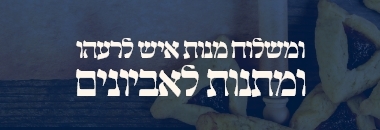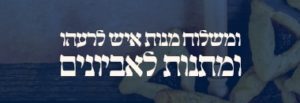In the previous article we discussed the contradiction that sometimes arises between the obligation to save lives on one hand, and the prohibition of murder on the other. A particular solution to such a contradiction is given by the halachah of rodef: Where there is no other way to prevent a pursuer from killing his intended victim, it is permitted, and even obligatory, to kill the rodef.
We attempted to define the parameters of the halachah, and saw how these parameters can have practical implications for different circumstances, such as a baby rodef, and the fascinating case of the Siamese twins.
In the present article we wish to continue the discussion of the rodef halachah, focusing on the weight questions that arise when many people can be saved from death by killing one or few people. Is it permitted to hand over a Jew to his death, if doing so will save an entire town from being killed? Is it permitted to attack a suicide bomber, and cause the death of those in his immediate vicinity, if this will prevent the murder of many? These questions, and other difficult issues, will be discussed below.
The Turning Over of Sheva ben Bichri
The story of Sheva ben Bichri and his revolt against King David is told in Shmuel II, Chap. 20. Yoav ben Tzeruya, David’s general, chases Sheva ben Bichri to Beit Maacha, and lays siege to the city. Just as Yoav is ready to breach the walls, a wise woman [Serach bas Asher, according to the Midrash] from the city calls down to Yoav and demands to know why Yoav seeks to destroy her city. Yoav responds that he seeks only the life of Sheva ben Bichri. The woman then instructs the people of the city to kill Sheva ben Bichri, and to throw his head over the wall to Yoav, thereby saving the city from destruction.
The legal significance of this story is spelled out in the Tosefta (Terumot 7:23):
If a group of people is approached by Gentiles and told: “Hand over one of you so that we can kill him, otherwise we will kill all of you,” they should all let themselves be killed rather than hand over a single Jewish life. However, if they specified a particular person, they should hand him over and not give up their lives, as in the case of Sheva ben Bichri.
Chazal derive from the story of Sheva ben Bichri that although it is prohibited to turn over a Jew, even in order to save many other lives, if the enemy demands a particular individual, it is permitted to turn him over. In this specific case, the rule of “one does not defer one life before another” is waived.
Turning Over an Innocent Individual
The Jerusalem Talmud (Terumos 8:4) cites a dispute between Amoraim concerning whether the above halachah applies even to an innocent individual, or whether it is limited to a guilty person such as Sheva ben Bichri, who was liable for death due to his rebellion against David. According to Rabbi Yochanan, the halachah applies universally; according to Reish Lakish, it applies only to guilty individuals.
Poskim disagree over the halachic ruling in this dispute. The Rambam (Yesodei Ha-Torah 5:5) rules according to Reish Lakish, and adds that even when the individual is guilty, and the person may be turned over, “we do not instruct this” (the rabbis must try to avoid giving the instruction of sending a person to his death). However, other authorities point out that in general, the halachah follows Rabbi Yochanan in his disputes with Reish Lakish (Yevamos 36a), and that the halachic ruling should therefore follow Rabbi Yochanan’s position. The Rema (Yoreh De’ah 157:1) mentions both opinions, without deciding between them.
The Taz (ibid.) concludes that the halachah should follow the Rambam’s stringent ruling, citing a similar stance from his father-in-law, the Bach. However, the Chazon Ish (Choshen Mishpat, Sanhedrin 25) writes that the principle halachah follows the opinion of Rabbi Yochanan, explaining that the halachah of turning over the requested individual is based on the concept of rodef: “The one that is singled out is considered a rodef, for his escaping among them causes them all to be killed. Although he does not have the full status of a rodef, because he does so to save his own life, nonetheless the entire town does not have to die, for he is the cause, and it is permitted to turn him over.”
Although the Chazon Ish proceeds to mention the ruling of the Rambam, whereby it is forbidden to hand over an innocent individual who was singled out by the enemy, it remains clear that his principle ruling follows Rabbi Yochanan’s broader conception of turning over the threatening individual.
Deflecting an ‘Arrow’
In addition to the above principle, the Chazon Ish (ibid.) offers a pivotal discussion concerning questions of saving many by killing few. The question addressed by the Chazon Ish is the case of “an arrow that is on its way to kill many people”: Is it permitted to deflect the arrow, so that the many will be saved, even when this will cause the death of an individual who would otherwise be safe?
Shut Tzitz Eliezer (Vol. 15, no. 70) demonstrates the practicality of this scenario. For instance, consider a car driver who, to his dismay, suddenly realizes that his brakes are gone. If he allows the car to continue on its downhill path, the lives of ten people will be endangered. He can pull the car over to the side of the road, but this will mean the probably death of one person. What should he do?
Other examples can be brought from warfare scenarios, such as when a hand grenade is thrown into a group of soldiers. A soldier has the option of deflecting the trajectory of the grenade, but although this will save the group, it will cause the death of other (fewer) soldiers. Is it permitted or obligatory to do so, and reduce the death toll, or is it forbidden to do so?
The Chazon Ish, in his response to the question, distinguishes between the deflection of an arrow, which is an act of saving people, and turning over an individual, which is “a cruel act of killing.” Handing over a person to his death is essentially an act of murder, the salvation of the town being only a by-product of the deed. By contrast, deflecting the arrow is essentially an act of saving lives, the consequent killing being an unfortunate by-product. The Chazon Ish thus writes that where the act is essentially an act of salvation, it is possible that we should seek to save as many people as possible, even at the cost of other lives.
Yet, the Chazon Ish is not certain of this ruling, and he proceeds to write that deflecting the arrow may be worse than turning somebody over, because it involves an actual act of murder (the case of Sheva ben Bichri, where the townspeople killed Sheva, is different, because he was actually liable for the death penalty).
In line with this concept, Rabbi Eliezer Waldenberg (Shut Tzitz Eliezer, loc. cit.) concludes that in the case mentioned above (of somebody whose brakes failed) shev ve-al taaseh adif—it is preferable to remain passive, even when a group of people will be killed, than to take the active step of killing others.
Killing One and Saving Many
Based on the above principles, authorities have discussed a number of most difficult questions.
In the previous article we mentioned the terrible case of the crying baby, who threatens to reveal a hiding place to the enemy—a question that tragically arose on many occasions during the Holocaust. Is it permitted to kill the baby, for the sake of saving the others, of is this forbidden because “one does not defer one life before another”?
In his Migei Ha-Harigah (no. 1) Rabbi Shimon Efrati discusses the question, and justifies those who killed crying babies by means of the above ruling of the Tosefta. The baby, according to his reasoning, is considered ‘singled out,’ and although he is surely innocent, it is permitted to kill him for the sake of saving the others. [He adds, however, that since the baby is not a willful rodef, there is no obligation to kill him.] Nonetheless, he also justifies (no. 3) those who did not kill crying babies, and lost their lives as a result—his own brother (Rabbi Tzvi Efrati) being one tragic example of many.
In tandem with his ruling, it is worth noting the opinion mentioned in last week’s article, which maintains that the principle whereby “one life is not deferred before another” does not apply where both lives with otherwise be sacrificed—for instance, where both mother and baby will die unless the baby is killed (see Minchas Avraham no. 42). Shut Panim Me’iros (Vol. 3, no. 8) derives this ruling from the above-mentioned case of Sheva ben Bichri: It was permitted to kill Sheva ben Bichri, who was specified for death, because otherwise the entire town would have been killed.
Based on this principle, Rabbi Yitzchak Zilberstein (Asia 45-46, Teves 5759, pp. 62-68) discusses a case that was practically relevant in the first Lebanon War (1982-85), where a car-bomb exploded outside an army headquarters, causing the five-story building to collapse. At the time there were more soldiers on the lower floors than on the higher floors, and in order to rescue soldiers in the lower floors, it was required to use heavy-duty engineering vehicles, which risked killing soldiers trapped in higher floors.
Rabbi Zilberstein, who addressed the theoretical question before the event took place (and also addresses a question of damaged ship carrying ten people that will sink unless three are thrown overboard), rules that if all the people present will die without the rescue operation, it is permitted to bring in tractors and cranes even if this will mean killing some of the soldiers on the higher floors.
Is There Permission to Kill?
In conclusion, Rabbi Zilberstein mentions the above opinion of the Chazon Ish, whereby it is permitted to deflect an arrow to save many from death, even when this causes the death of individuals. In the same vein, it is permitted for the rescue tractors to enter, even at the cost of life.
Yet, we saw above that the Chazon Ish draws a distinction between an act that is essentially an act of saving life, which is possibly permitted even if it also kills, and an act whose essence is killing, which is forbidden even if it saves life. In the spirit of this distinction, Rabbi Shlomo Dichovsky contends Rabbi Zilberstein’s ruling, arguing that the case of the rescue operation in incomparable with the case of killing an infant to save its mother: In the case of killing an infant, the very death of the infant saves the mother. In the case of the rescue operation, causing the death of some soldiers is not directly involved in saving others, and their killing cannot be defined as an ‘act of salvation.’
According to Rabbi Dichovsky, there is therefore no support for a lenient position with regard to an act of killing that is not a direct act of saving live, and his conclusion (concerning the case of the rescue operation) is that—despite the great pain involved in such a decision—it is forbidden to carry out the operation.
As to the argument of the Panim Me’iros, whereby in cases where all are destined to be killed it is permitted to kill in order to save others, Rabbi Dichovsky mentions a number of authorities that dispute this stance, and argue that it remains prohibited to take a life. In particular, when no single person is ‘singled out,’ one may not be lenient in transgressing the prohibition of murder.
A similar ruling is mentioned in Mishnas Pikuach Nefesh (no. 49, sec. 6), with regard to the question of disconnecting a life-support machine from one patient, for the sake of saving several patients. Again, the disconnection of the machine cannot be considered an act of saving life; rather, it is an act of killing that enables saving lives. Based on the Chazon Ish’s distinction, this act of killing cannot be permitted.
Killing a Suicide Bomber
What is the halachah where a suicide bomber is spotted at the entrance to a crowded hall, when his intention is clearly to detonate in the hall, causing multiple deaths? The person who notices the terrorist is able to kill him on the spot, but this will inevitably lead to the detonation of the device, and the death of those in the immediate vicinity. Is it permitted or obligatory to kill the terrorist, together with those in his immediate vicinity, or is this prohibited?
It appears that this case is similar to the cases above, in which we saw a dispute between Rabbi Zilberstein and Rabbi Dichovsky, such as the rescue operation that will inevitably kill some soldiers. Furthermore, in this case even Rabbi Zilberstein might concede that it is forbidden to cause the deaths of bystanders, because those outside the hall will not die if the terrorist is left alone, and the ruling of the Panim Me’iros does not apply. Clearly, the bystanders cannot be defined as being ‘singled out’ to die, and based on the Tosefta, it will not be permitted to cause their deaths.
On the other hand, it is possible that the case of the terrorist is more lenient than the rescue operation, because the actual killing of the terrorist does not involve causing other deaths, and this will only result if the terrorist manages to detonate. The actual act is therefore not an act of killing, and even Rabbi Dichovsky might concede that it is permitted (and therefore obligatory).
The author of Mishnas Pikuach Nefesh (no. 50) posed a similar question to Rabbi Chaim Kanievsky, concerning whether a hijacked airplane, whose hijackers plan to fly into a multi-storey building, can be blown up before it reaches its target. Rabbi Kanievsky replied that “we are in doubt concerning this question.”
A Clear Act of Self-Preservation
The Damesek Eliezer (Perlmuttar, Introduction, p. 4) raises the following question: “I was asked concerning two people who stand one behind the other, and a murderer wishes to kill the person standing in front: Is it permitted for the person to duck or to jump aside, so that the arrow directed at him will kill the person standing behind him?”
A similar question is mentioned in Mishnas Pikuach Nefesh (no. 50), concerning an Israeli soldier who noticed a missile had been fired at him in battle. The soldier ducked to save his life, and a soldier standing behind him was struck by the missile, and killed. The soldier now wishes to know if he needs to repent and atone for the sin of causing the death of his colleague.
The Damesek Eliezer replies: “I responded that in my humble opinion, it is simple that this is permitted, because he does not perform any active deed, but only saves himself.” In this case, there is no active deed of killing whatsoever, and it is clear that the act is essentially an act of self-preservation. Although this will result in the death of his colleague, this is not sufficient to prohibit his saving himself from death by ducking or diving aside.[1]
In the same vein, there is room to debate a further question that arose from the Nazi camps, where for every inmate who escaped the Nazis killed a number of inmates. Is it permitted for an inmate to escape, in the knowledge that this will cause the certain death of several inmates? As in the case above, the act of escaping is clearly an act of self-preservation, and not an act of killing, and therefore it appears that it is permitted to do so—even though this will cause the deaths of several inmates.
This ruling is all the more true where as inmates of a Nazi camp, the chances of survival are in any case extremely slim. Yet, there is room to argue that the case of escape from the camp is more stringent that ducking the missile, because escaping actually creates a new danger, whereas in the case of the missile the danger has already been created by the enemy.
[1] However, see Damesek Eliezer, who continues to cast doubt over the ruling. There is also room to discuss whether the principle of “your life comes first” (Bava Metzia 62), which the Talmud ruled concerning a case of two travelers in the desert with only one jug of water between them, applies here (where ducking positively causes the death of the man behind).










